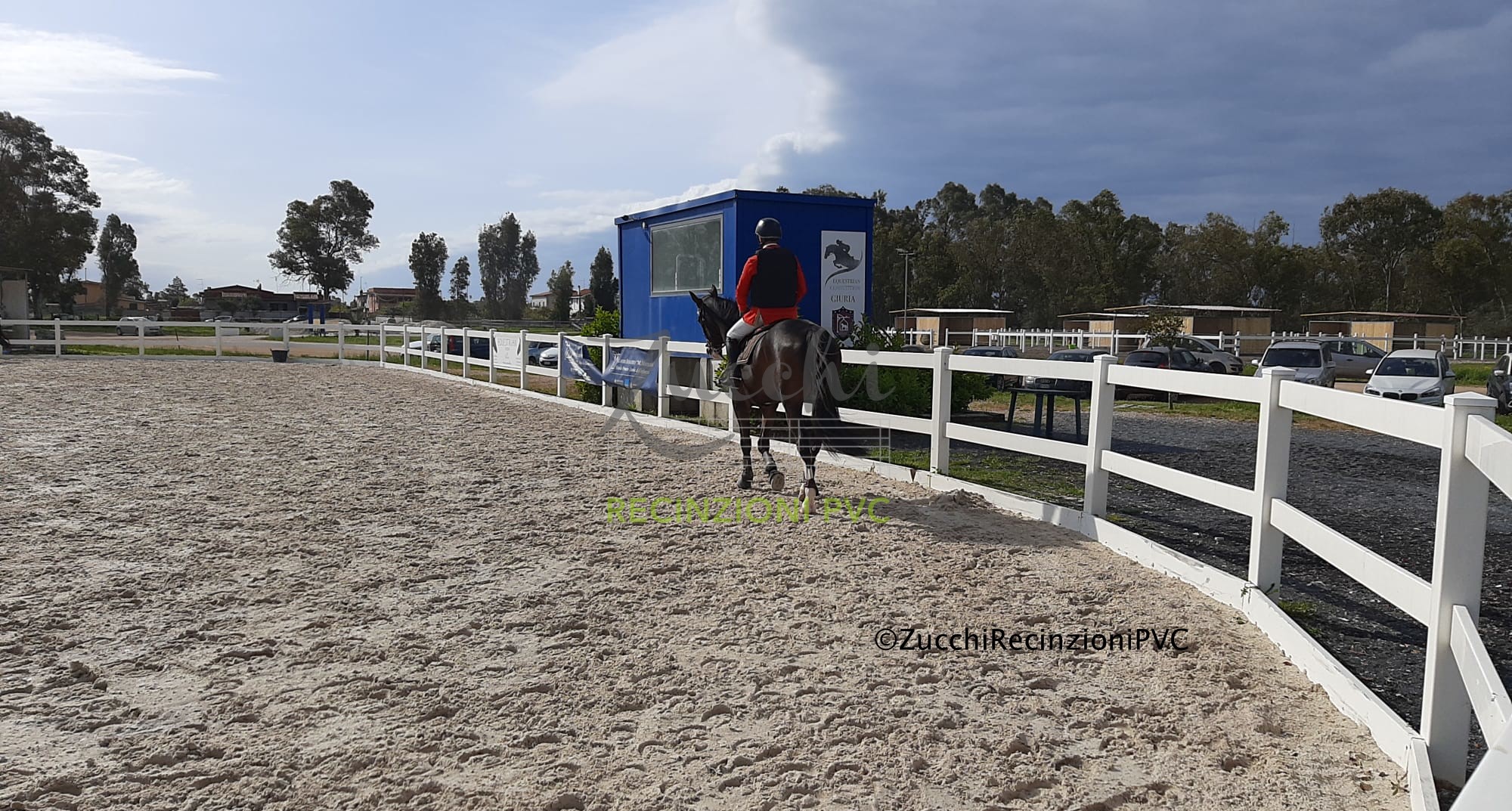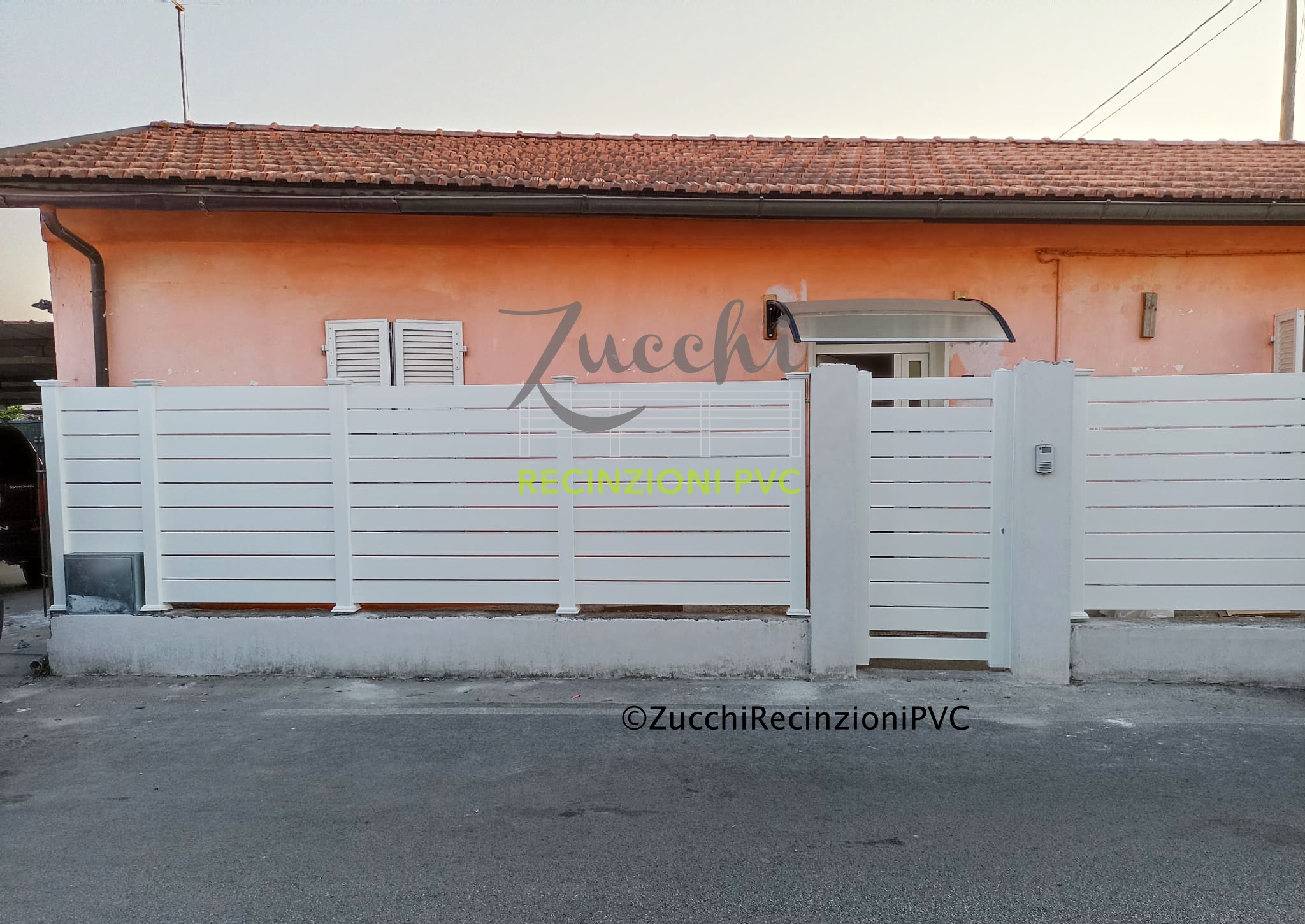Materials compared: wood, PVC, round bar
Discover what’s truly best for fences and structures in your equestrian center
If you own a riding school, an equestrian center, or simply care for horses every day, you’ve probably asked yourself this question:
“What is the best material for fences, stalls, and paddocks?”
The easy answer is: it depends on you.
But today we’ll help you compare wood, PVC, and round bar, the three most used materials in Italian riding schools, so you can make a more informed choice.
We won’t use technical jargon or bore you with endless datasheets.
Just real-world experience, genuine advantages, and little details that will save you headaches (and maybe prevent a horse escape).
Wood: the classic everyone loves, but…
Wood is like pasta: you find it everywhere, you’ve always known it, and at first, it always seems like the best choice.
It’s natural, visually appealing, loved by clients, and gives your equestrian center that rustic, welcoming look everyone loves.
If you have school horses or offer family rides, a nice wooden fence makes an immediate impression.
But beware: wood is also the material that requires the most maintenance.
You need to paint it, check for cracks, treat it against woodworms, tighten screws, and often replace it after a few years.
If it rains frequently in your area, it may rot or become slippery.
Also, some horses chew on it out of boredom, damaging the structure and risking their teeth.
And if you manage lively or dominant horses, you know how… “creative” they can get with fences. Practical tip: if you choose wood, go for hard types and treat the material every year. It costs more, but it lasts longer.
PVC: lightweight, modern… but strong enough?
In recent years, PVC has gained quite a bit of ground in riding schools, especially in more modern centers.
It’s easy to install, doesn’t get damaged by rain, and looks great: white, neat, and “clean.”
Plus, it doesn’t splinter like wood, so it may seem like a safer choice for horses and clients.
Less work for you, fewer injury risks: on paper, it seems like the perfect material.
But… yes, there’s always a “but.”
PVC isn’t always strong enough for the heavy use horses put it through.
A well-aimed kick, a sudden escape, or a panicked horse, and crack: it can break.
Not all PVC is the same: if you choose versions that are too light or “garden-grade,” they won’t last long and can warp in the sun.
Also, watch out for the cold: some PVC fences become stiff and brittle in winter.
Round bar: the tough one in the group (that won’t let you down)
Round bar is like that old friend who doesn’t say much, but when needed… is there.
Sturdy, discreet, durable, and able to withstand the worst: water, sun, mud, stubborn horses, and careless clients.
We’re talking about solid or tubular round steel (preferably galvanized), used for fences, modular stalls, paddocks, and even work areas.
It’s the material preferred by those who want to sleep peacefully at night, knowing no horse will wander off on its own.
The great thing about round bar is that it has no sharp edges, is hard to break, and lasts a very long time.
You don’t need to paint it every year or perform constant maintenance: a big difference compared to wood.
And even if it costs a bit more upfront, it pays off over time with its durability.
It can be anchored to the ground with posts, cemented, or welded to larger structures: it’s flexible, solid, and truly versatile.
Equine behavior and smart fencing
Understanding horses to build truly hoof-proof structures
If you have an equestrian center or riding school, you’ve probably already realized that a perfect fence on paper… can fail in reality.
Why? Because horses are extraordinary, intelligent, curious animals and—let’s be honest—also a bit mischievous when they want to be.
Designing a fence isn’t just about choosing the right material, but also understanding how your horses behave every day.
In this article, I’ll guide you simply through typical equine behaviors and smart fencing that actually works.
Naturally curious: when a horse pokes its nose where it shouldn’t
Horses are social, curious animals, always alert to what’s happening beyond the fence.
If they hear a noise, smell something new, or see another horse, they instinctively move closer to investigate.
And that’s exactly when trouble starts: they stick out their heads, touch the mesh, or poke their noses between the bars.
If the fence isn’t solid or well-designed, the risk of accidents is very high.
A horse that gets stuck by its head or leg can get seriously hurt, and can also cause panic in the herd.
And if it happens while a client is nearby, the disaster is complete: risks for the animal, and for your reputation.
Smart barriers are those that don’t spark curiosity and don’t provide grips or openings to explore.
Fewer corners, fewer gaps, fewer problems—and you can sleep more peacefully.
.
Sudden escape? Here’s what drives a horse to run
Even the calmest horse in the world can suddenly decide it wants… to be somewhere else.
A loud noise, a wild animal, lightning, or a dominant horse bothering it: panic takes over.
And when a horse decides to run, it doesn’t care about corners or fences: it charges, hoping something will give way.
This is where the material’s strength—and the fence’s flexibility—comes into play.
If it’s too rigid, it can break and create dangerous edges. If it’s too soft, it gives way and the horse escapes.
Round bar, if chosen in the right size and properly installed, is one of the few materials that combines flexibility and strength.
It can absorb a hit, but doesn’t break like wood or shatter like cheap PVC.
And remember: a fleeing horse can injure itself, endanger other animals, and cause damage even outside the riding school.
Dominance, boredom, and play: horses interacting with fences
Not all horses spend their day in the paddock the same way.
There’s the one that paces back and forth constantly, the one that naps in the sun, and the one that… destroys everything.
Some horses bite, pull, or push fences to vent, play, or assert their position in the herd.
And if there’s a young or dominant horse in the paddock, it’s almost certain it will test the limits of the structure.
They do it for play, boredom, or to get closer to others.
And it’s in these moments that a weak fence is put to the test.
If you’re using wood or PVC without reinforcements, be prepared for frequent repairs.
A damaged fence, even in just one spot, makes the entire area less safe.
Moreover, round bar doesn’t provide surfaces to chew or edges to lift, so it reduces destructive behavior from the horse.
The eye wants its share… but the horse is watching too!
Do you know what horses notice more than customers? The small irregularities.
A piece of fencing that vibrates, a leaning post, a part that sounds strange: they notice it immediately.
And when something changes in their environment, they explore it – with their nose, hoof, and often, even their teeth.
For this reason, a “smart” fence must also be visually consistent, without different, broken, or misaligned parts.
It may seem like a detail, but maintaining the uniformity of the structure helps horses feel safe and less stressed.
And calmer horses = fewer dangerous behaviors.
Winter paddocks: drainage and durability
How to avoid mud, endless puddles, and unhappy horses
Winter is nice for those cozy with a cup of tea… but for you managing a stable, it means only one thing: mud, mud everywhere.
If your paddocks turn into swamps after just two days of rain, this article will save your season (and maybe even your fences).
Let’s talk about drainage, smart materials, and fences that hold up even in pouring rain.
The mud drama: public enemy number one of the paddock
You know it well: when it rains for days, horses start sliding in the mud as if they were at a rodeo.
The ground cracks, ruts form, their hooves sink, and with a bit of bad luck, lameness and infections can follow.
The problem isn’t just aesthetic (even if your paddock looks like a battlefield): poor drainage puts the horse’s health at risk.
Stagnant water, compacted mud, and soft ground are the perfect mix for dermatitis, infections, and stressed hooves.
And then there’s you, who every morning has to shovel, empty, dry, and hope the weather gets better.
Spoiler: it doesn’t. And the season is still long.
Even just 5–10 cm of slope can change everything, helping water flow away instead of creating a mini Lake Garda.
And remember: no material works miracles if there’s a puddle underneath.
Smart materials: what really withstands winter
In winter, everything is put to the test: horses, staff… and materials.
If your fences start giving way at the first hoof strike on soft ground, it’s time to rethink the structure.
Wood absorbs water, swells, rots, and often shifts in muddy ground, becoming unstable.
PVC can bend or break if exposed to strong wind or intense cold.
And this is where round steel comes in, the material that isn’t afraid of bad weather.
We’re talking about solid or galvanized round steel, capable of withstanding moisture, mud, and even the impacts of restless horses.
Moreover, if you mount it on movable bases or well-secured posts, it won’t shift even when the ground softens under the rain.
It’s perfect for marking winter paddocks without having to rebuild them from scratch every year.
Comfort for the horse = fewer problems for you
A well-drained paddock, made with durable materials, makes the horse happy and helps you work better.
Horses need space, movement, dry ground, and safe fencing. If even one of these elements is missing, problems start.
In constant mud, many horses move less, get more stressed, and become nervous even during lessons or rides.
Sometimes the horse even avoids certain areas of the paddock to avoid sinking, limiting movement and natural release.
A smart fence, like those made of round bars, doesn’t obstruct the view or create barriers that are too rigid.
This way, the horse moves freely, while you maintain control and safety.
Avoid unprotected electric wires or makeshift metal posts: in winter, humidity increases electrical risks.
Better to use stable, smooth, and well-insulated materials: round bars, if properly installed, offer all this without the need for electricity.
Organize the paddocks with the worst season in mind
Many riding centers design paddocks and fences with summer in mind: happy horses, dry ground, and minimal maintenance.
But then November arrives, and suddenly everything turns into an unusable swamp.
The secret is to design fences and materials with winter in mind from the start.
You don’t have to redo everything every year: just choose the right spots, durable materials, and plan for drainage during installation.
And if your ground is really challenging, consider dividing the winter paddocks into smaller, rotatable, and elevated areas.
Use coarse gravel or stabilized material beneath a draining layer — it really works.
Ideal space for calm and active horses
How to create environments that improve well-being and simplify your life
A happy horse is a horse that moves, plays, relaxes, and interacts in a well-designed environment.
And when the horse feels good, you breathe easier too, because emergencies decrease, clients notice, and the riding center runs smoothly.
In this guide, I’ll show you how to create an ideal space for calm, active, and healthy horses, without complicating your life.
Daily movement: why space makes a difference
Horses are not meant to stand still. Their nature is made of movement, socialization, and constant exploration of their surroundings.
Even if you work with them every day, they are still animals that need to move freely for several hours a day.
If the paddock is too small, narrow, or uncomfortable, the horse doesn’t burn off energy, gets bored, and becomes easily stressed.
This results in problematic behaviors like biting, kicking the stall, compulsive walking, or reactions during work.
When the horse can trot, roll, and move away from its peers if it wants, stress is reduced and it stays fitter.
And you immediately notice the difference in management too: less nervousness, fewer stall-related illnesses, and calmer horses.
Active and safe paddocks: how to design smartly
An ideal space isn’t just large: it’s smartly designed, considering the horse’s well-being and safety.
It needs resting areas, shady spots, drained zones, and reliable fencing: only then can the horse move safely.
In an active paddock, the horse finds different stimuli: it changes position during the day, interacts with others, and self-regulates.
But all this requires strong, well-installed fencing that doesn’t give way to pushes or energetic play.
Wood deteriorates, PVC cracks over time, and electric fences pose accident risks, especially if there is mud or moisture.
This is why many riding centers are switching to galvanized round bars, which offer strength, flexibility, and visual safety.
A space designed like this encourages spontaneous movement, prevents conflicts between horses, and reduces the time you spend fixing damage.
Social interaction and space: balance between freedom and control
Horses are social animals: they thrive when they can see, sniff, and communicate with other horses in the paddock.
But be careful: too much proximity can lead to tension, especially between horses that don’t get along or in spaces that are too small.
The goal is to find a balance between freedom and safety, separating horses when necessary but without isolating them completely.
Round bar fences, for example, provide visibility and contact without allowing direct clashes or dangerous bites.
A horse that interacts without fighting develops more balanced behaviors even during work or with clients.
And if you notice too much agitation, you can easily reconfigure the space if you used modular or easy-to-move fencing.
Giving space doesn’t mean leaving everything to chance: it requires strategy, smart design, and materials that make your life easier.
Higher quality space = fewer problems for you
When the space is truly designed for horses, you notice that every day at the riding center is smoother and more enjoyable.
Calmer horses, fewer injuries, fewer fence breaks, fewer last-minute emergencies.
And the client notices immediately: a tidy riding center, with calm horses and well-organized spaces, inspires instant trust.
It becomes a strength in communication, guided tours, social media photos, and word of mouth.
Remember, every detail matters: from ground drainage to fence material choice, to managing access.
And you can choose a solution that lasts over time and minimizes maintenance, giving you more time for the horses.
In conclusion…
Creating the ideal space for calm and active horses doesn’t require magic, but smart and conscious choices.
More freedom of movement, durable materials, flexible design, and horses that feel good even when you’re not watching.
And when the horse is calm, your work also becomes easier, safer, and more rewarding.
So yes, designing better spaces benefits everyone: the horse, your team, the client… and you too.







Leave A Comment